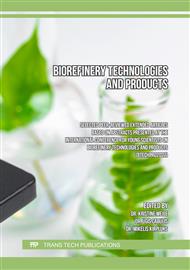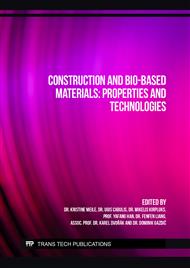p.174
p.182
p.189
p.197
p.204
p.215
p.222
p.229
p.235
Study of a Novel Biorefining Method for Obtaining 2-Furaldehyde, Acetic Acid and Pulp from Birch Wood
Abstract:
Necessity for reduction of greenhouse gases emissions, the growing demand for improvement of biorefinery technologies and the development of new biorefining concepts, oblige us as a society, mainly scientists, to develop novel biorefinery approaches. The aim of this research was to comprehensively characterize lignocellulosic biomass that was obtained after 2-furaldehyde production, in terms of further valorization of this resource. This research shows that birch wood chips can be used in the new biorefinery processing chain for production of 2-furaldehyde, acetic acid and subsequent cellulose pulp obtaining, using thermomechanical and alkaline peroxide mechanical pulping process. In addition, obtained lignocellulosic residue was also characterized. Unique bench-scale reactor system was used to obtain a lignocellulosic material without pentoses and with maximum preservation of cellulose fiber for further use. Studies on the deacetylation and dehydration of birch wood hemicelluloses of pentose monosaccharides to 2-furaldehyde and acetic acid using orthophosphoric acid as a catalyst were carried out. Results showed that depending on the used pretreatment conditions the 2-furaldehyde yield was from 0.04 to 10.84 % o.d.m., the acetic acid yield was from 0.51 to 6.50 % o.d.m. and the lignocellulose residue yield was from 68.13 to 98.07 % o.d.m. with minimal content of admixtures. In addition, experimentally the optimal 2-furaldehyde production conditions regarding to purity and usability of cellulose in leftover of lignocellulosic material were developed. Best results in terms of both 2-furaldehyde yield and purity of residual lignocellulose were obtained in experiment where catalyst concentration was 70%, catalyst amount 4 wt.%, reaction temperature 175 °C and treatment time 60 min. By performing alkaline peroxide mechanical pulping of the relevant LC residue, it was possible to obtain pulp with tensile index comparable to standard printing paper, indicating that it is possible to perform stepwise 2-furaldehyde production with subsequent pulping to obtain various value added products.
Info:
Periodical:
Pages:
204-211
Citation:
Online since:
October 2022
Authors:
Price:
Сopyright:
© 2022 Trans Tech Publications Ltd. All Rights Reserved
Share:
Citation:



